IBHOF Class of 2016 – How I voted and why
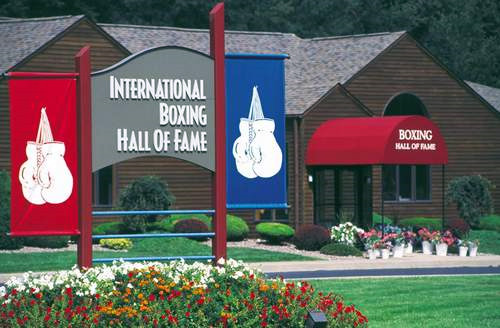
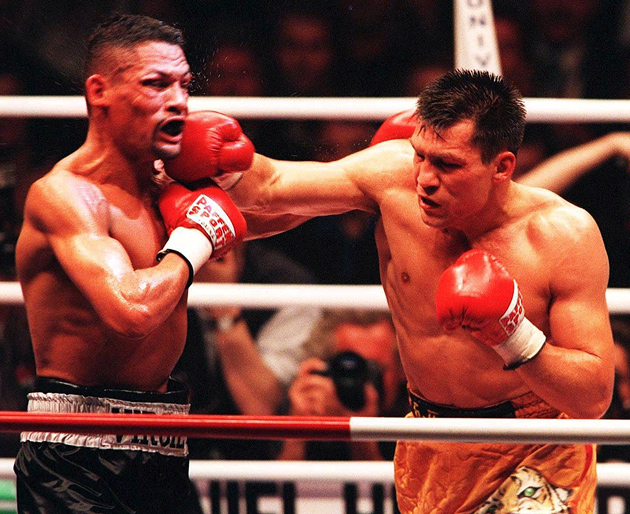
Dariusz Michalczewski (right) lands a right to Virgil Hill en route to a decision victory over the Class of 2013 Hall of Famer. Will Michalczewski make the Class of 2016? Photo by Gerd Scheewel / Bongarts / Getty Images
Every year since 2001 I’ve had the privilege of being an elector for the International Boxing Hall of Fame. As someone who reveres the sport’s history it is especially gratifying to have a voice in terms of who will be immortalized. It is a responsibility I approach with utmost seriousness and while I’ve often disagreed with the final results of the Modern category – I didn’t vote for either Ray Mancini or Riddick Bowe for the Class of 2015 but did affix my check mark for Naseem Hamed – I’ve always enjoyed the whittling-down process.
For the second consecutive year I received ballots for Modern, Old-Timer, Non-Participant and Observer; in the previous 13 cycles I had voted on just the Moderns. Because of the new protocol adopted last year that introduced a rotating ballot I will be voting for the “Early Era” Old Timers whose careers ended between 1893-1942 instead of the “Late Era” candidates whose careers concluded between 1943-1988. Since I had never previously considered the names on the “Early Era” ballot, I knew that would take up a considerable share of this year’s deliberations.
My first order of business, as always, was the Moderns. The first thing I do when I open the envelope is to spot the three new names and I was pleasantly surprised to see two figures for which I had long advocated – longtime flyweight titlists Yuri Arbachakov and Sot Chitalada. Hector “Macho” Camacho was the third new entry, an option I had anticipated for a couple of years.
In November 2003 I wrote a three-part series for MaxBoxing.com entitled “The IBHOF’s Deserving Dozen” in which I profiled candidates who had been retired long enough to be eligible but had somehow slipped through the cracks. Of those, three have since been inducted (Humberto “Chiquita” Gonzalez, Danny “Little Red” Lopez and Jung Koo Chang) while five others subsequently made the ballot (Santos Laciar, Lupe Pintor, Miguel “Happy” Lora, Gilberto Roman and Sung Kil Moon). The additions of Arbachakov and Chitalada increased that total to seven, and I’m holding out hope that the final two names in the article – 115-pound monarch Jiro Watanabe and early 108-pound titlist Luis Estaba – will join them someday.
Up until last year I would have simply scanned the ballot, check off names and put my ballot in the mail because we voters had far more latitude — a maximum of 10 checks among the 45 names. Under the new guidelines, however, we voters must be far more selective as we are permitted just five check marks among the 30 choices. My process was further narrowed because three of my check marks were already reserved for Dariusz Michalczewski, Gilberto Roman and Hilario Zapata, whose candidacies I strongly recommended for reasons that were chronicled in last year’s article. Therefore, I had only two checks remaining for the other 27 names.
As I’ve long stated, I believe a Hall of Famer is someone who blends outstanding talent with sustained dominance. Some believe “fame” alone (read “popularity”) is enough to earn enshrinement but to me a lesser-known fighter with a similarly outstanding skill set and a superior resume should always get in before a “fame” fighter. Considering who had been elected recently, this apparently is a minority view among the current voting pool but I will stick to my principles as long as I continue voting.
Although I voted for Sung Kil Moon last year, I didn’t feel strongly enough about his candidacy this time around to affix one of the final two checks without first reviewing the other names. He did, however, earn an automatic bye into the second round of deliberations.
Those that didn’t were Vinny Pazienza (8-7 versus champions and Hall of Famers), Fernando Vargas (5-5), Leo Gamez (5-12), Rocky Lockridge (3-9) and Meldrick Taylor (2-4). I also eliminated fighters that didn’t make the cut in past years such as Samuel Serrano (nice reign but too many obscure foes, never unified against Alexis Arguello or Alfredo Escalera and posted a 2-3-1 record against his best foes), Donald Curry (a great start but was never the same after losing to Lloyd Honeyghan), Ratanapol Sor Vorapin (long-reigning champ lost to perennial counterpart Ricardo Lopez early in their careers and was 2-3 against his best foes), Paulie Ayala (onetime RING Fighter of the Year only had a three-defense reign at 118 and was a modest 5-3 against the best), Sven Ottke (a fantastically long reign but though he retired undefeated he benefited from too many questionable hometown decisions and never unified against Joe Calzaghe) and James “Buddy” McGirt (incredible technician earned everything the hard way and brilliantly out-boxed Simon Brown to win his second belt, but his reigns at 140 and 147 were far too brief in comparison to his peers).
Those eliminations left me with 14 names to fill the remaining two slots. At this point the tweezers had to come out, for while each had undeniable plusses they also had deficits that eliminated them:
Orzubek Nazarov – The Russian left-hander followed an excellent amateur career with a WBA title reign at 135 that eventually merited top-10 pound-for-pound consideration. He won the title from Dingaan Thobela in South Africa and consolidated that decisive win with another – again on the road. He stopped ex-champ Joey Gamache in Maine and future titlist Leavander Johnson in Florida. His six defenses included four knockouts, after which he lost a lopsided decision to Jean-Baptiste Mendy in France in what would be his final fight. While “Gussie” put together a quality reign injuries prevented him from maximizing his time at the top. Had he remained healthy he may well have done enough to craft an airtight case. Unfortunately, voters can only consider what was, not what could have been.
Julian Jackson – This two-division titlist was one of history’s hardest hitters shot-for-shot and pound-for-pound. His single-shot knockouts of Terry Norris, Herol Graham and Buster Drayton are all-time highlight-reel material and at one point 37 of his victories (not 37 straight fights) were by knockout. He also captured a second 160-pound belt (albeit vacant) at age 35 against Italian Agostino Cardamone. I believe he had the talent to craft an even more impressive career but the matches that would have enhanced his profile (rematches with McCallum and Norris) were never made for a variety of reasons. As much as I would like to vote for Jackson, he had a 3-5 record against titlists and Hall of Famers and given the tiny crevice that remains that’s not enough to get through.
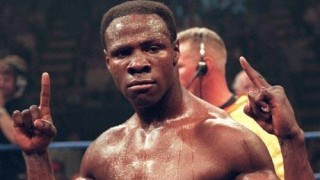 Chris Eubank – Eubank ranks with the very best in terms of showmanship and the fact he won WBO belts at 160 and 168 speaks well of his skill level. The 14 defenses he stuffed into his three-and-a-half year reign at super middleweight ranks only behind Calzaghe’s and Ottke’s division record of 21 and his consecutive wars with Michael Watson were genuine ring classics (though the rematch ended with a career-ending brain injury to Watson). This is what hurts his cause: Even though he won a lot of fights, he didn’t dominate. He liked to ride the razor’s edge when it came to decisions and it could be argued that a few of them should have gone to the other guy. Even so, “Simply The Best” was still just 4-5-1 against fellow titlists and Hall of Famers, although two of the defeats occurred when the outsized (but still ripped) Eubank unsuccessfully challenged WBO cruiserweight titlist Carl Thompson in a pair of underrated thrillers. He was just 31 when he fought his last match and after starting his career 41-0-2 he went 4-5 in his final nine. It would be one thing if he fell on hard times when he was in his mid-30s or beyond but here he was still a relatively young man chronologically.
Chris Eubank – Eubank ranks with the very best in terms of showmanship and the fact he won WBO belts at 160 and 168 speaks well of his skill level. The 14 defenses he stuffed into his three-and-a-half year reign at super middleweight ranks only behind Calzaghe’s and Ottke’s division record of 21 and his consecutive wars with Michael Watson were genuine ring classics (though the rematch ended with a career-ending brain injury to Watson). This is what hurts his cause: Even though he won a lot of fights, he didn’t dominate. He liked to ride the razor’s edge when it came to decisions and it could be argued that a few of them should have gone to the other guy. Even so, “Simply The Best” was still just 4-5-1 against fellow titlists and Hall of Famers, although two of the defeats occurred when the outsized (but still ripped) Eubank unsuccessfully challenged WBO cruiserweight titlist Carl Thompson in a pair of underrated thrillers. He was just 31 when he fought his last match and after starting his career 41-0-2 he went 4-5 in his final nine. It would be one thing if he fell on hard times when he was in his mid-30s or beyond but here he was still a relatively young man chronologically.
Genaro Hernandez – “Chicanito” parlayed his willowy frame to two distinguished reigns at 130, the first starting in France against Daniel Londas and the second achieved on points against Hall of Famer Azumah Nelson. Other plusses: He twice beat longtime 118-pound titlist Raul Perez, outpointed Carlos “Famous” Hernandez and flattened Jorge Paez. He lost only to the very best – Oscar de la Hoya and Floyd Mayweather Jr. – and had there been seven more checks available I probably would have used one for him. Unfortunately, there were only two.
Michael Moorer – “Double M” was a fantastic light heavyweight as he amassed nine defenses of the then-lightly regarded WBO title and it could be argued that he could have emerged victorious in the potential unification round-robin against Prince Charles Williams, Virgil Hill and stable mate Dennis Andries. Weight-making difficulties (and the usual political infighting by the sanctioning bodies) prevented Moorer from taking part. But his biggest impact came at heavyweight where he became the division’s first southpaw champion after upsetting WBA/IBF king Evander Holyfield, then, after being on the wrong end of a historic shocker against 45-year-old George Foreman, Moorer won the IBF belt by beating Axel Schulz in Germany. He lost the title back to Holyfield, suffering five knockdowns in the process. He never again challenged for a belt, and he did end his career in unusual fashion as he won his last six fights, four by KO.
To me, Moorer had Hall of Fame level talent and he began his career with 26 straight knockout wins, one of the longest such strings in ring history. I believe he will earn Hall of Fame enshrinement – maybe even this year – but again, the limited number of checks available prevented me from investing one here.
Gianfranco Rosi – Another tough out. In many ways he had a successful career: Two reigns at 154 that totaled 12 defenses and nearly six years and had it not been for a failed drug test following his win over WBO titlist Verno Phillips he would have become a three-time monarch at age 38. He was 8-4-1 against his fellow titlists and eventual Hall of Famers, another plus for me, and he had enough skills at 48 to win – and defend – a regional middleweight title before being stopped in his last fight. What eliminated him from the field was that he didn’t get over the hump when he met his very best opposition. Before both were champions Lloyd Honeyghan crushed Rosi in three rounds to win the Italian’s European welterweight title and a past-his-best Donald Curry breathed new life into his career at Rosi’s expense, dropping him five times and forcing a corner retirement between rounds nine and 10 before the Italian’s home crowd in San Remo. Rosi was good, and at times very good, but not quite good enough to get the check.
Those eliminations left me with 10 names – the three new kids on the block (Camacho, Arbachakov and Chitalada) and returnees Nigel Benn, Santos Laciar, Miguel Lora, Henry Maske, Sung Kil Moon, Lupe Pintor and Wilfredo Vazquez Jr. At this point, the emphasis was more on identifying who in this group I felt did the most to earn enshrinement than nit-picking the shortcomings. The process was difficult but in the end I felt comfortable with my final choices:
Wilfredo Vazquez Sr.: In my eyes the case for Vazquez Sr. was always strong but his candidacy suffered only because of the presence of stronger names. Now that those names have been enshrined – and because this year there are no obvious shoo-in first-timers – the career of “El Orgullo de Puerto Rico” was deemed worthy of the check.
Why?
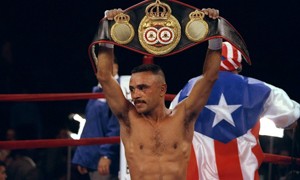 First, while a select number of fighters have won a world title after losing their pro debut, even fewer have gone on to become a titlist in three weight classes. Vazquez is one of those fighters, for after losing a four rounder to William Ramos, then losing two bouts in a three-fight stretch against WBC bantamweight king Miguel Lora and former WBC flyweight titlist Antonio Avelar in a sensational shootout, Vazquez won the WBA bantamweight title, by knockout, in South Korea, over Chan-Yong Park, whose only loss in his last 19 fights was a 10-round decision to future Hall of Famer Khaosai Galaxy.
First, while a select number of fighters have won a world title after losing their pro debut, even fewer have gone on to become a titlist in three weight classes. Vazquez is one of those fighters, for after losing a four rounder to William Ramos, then losing two bouts in a three-fight stretch against WBC bantamweight king Miguel Lora and former WBC flyweight titlist Antonio Avelar in a sensational shootout, Vazquez won the WBA bantamweight title, by knockout, in South Korea, over Chan-Yong Park, whose only loss in his last 19 fights was a 10-round decision to future Hall of Famer Khaosai Galaxy.
Second, including the Park win, all three of Vazquez’s championships were won as a road underdog by knockout. After losing the 118-pound belt to Khaokor Galaxy (L 12) he lost his next fight to Raul “Jibaro” Perez by decisive 10-round decision, then, three fights later, was stopped in one round by Israel Contreras, himself a future belt-holder. Who would have ever expected Vazquez to capture his second divisional title just four fights later from his previous conqueror Perez, who had just won his second divisional belt following a dominant reign at bantamweight, in Mexico, with a smashing third-round knockout? Then, just three months shy of his 36th birthday, Vazquez won his third belt with a come-from-way-behind 11th round TKO over WBA featherweight king Eloy Rojas.
Third, not only did he win belts at 122 and 126, he kept them and he beat quality fighters in the process. His 122-pound reign spanned three years and nine defenses and his best wins came against future titlists Thierry Jacob (KO 8, KO 10), former 122-pound belt-holder Luis Mendoza (W 12), eye-blink 115-pound titlist Juan Polo Perez (W 12) and future Hall of Famer Orlando Canizales (W 12) in what was considered a surprise. After dethroning Rojas at 126, he notched defenses against Bernardo Mendoza (KO 5), Yuji Watanabe in Japan (KO 5), Roque Cassiani (W 12) and Genaro Rios (W 12). Vazquez only lost the title due to politics, for instead of fighting a mandatory against previous conqueror Antonio Cermeno he opted to meet WBO king Naseem Hamed for considerably more money and prestige. Even four months shy of 38, Vazquez fought “The Prince” credibly before losing by seventh round KO.
Yes, Vasquez had some shortcomings and stumbles – four of his nine defeats were by KO and he really struggled with tall speedsters – but in my eyes his accomplishments and his ability to overcome career adversities and adverse situations far out-weigh his negatives. That’s why he made the grade with me.
Henry Maske: In my opinion, this German “Gentleman” had lots of positives and relatively few negatives. The positives include stuffing 10 defenses during his 44-month reign as IBF light heavyweight champion, most of which were lopsided points victories. When one includes his title-winning victory over Prince Charles Williams, Maske earned the maximum number of points in a given round 82.9% of the time in his victorious title fights, which compares favorably to the best mathematical stretches enjoyed by Roy Jones Jr. (88.8% in 21 fights), Pernell Whitaker (84.3% in 11 fights), Wladimir Klitschko (83.7% in 12 fights) and Floyd Mayweather Jr. (82.4% in 24 fights). Unlike other German-based champions, Maske didn’t need much help from sympathetic judges. He did a good job piling up points on his own, which is what he had to do since he wasn’t blessed with fight-ending power. To me that demonstrates a high degree of skill as well as a proven dominance at the highest levels of the sport, two key assets I look for in a Hall of Fame candidate.
 His best wins came against Williams, two-division titlist Graciano Rocchigiani (who he beat twice) and three-division titleholder Iran Barkley. He also turned back unbeatens Ernie Magdaleno, Egerton Marcus and Duran Williams as well as 1988 U.S. Olympian Anthony Hembrick.
His best wins came against Williams, two-division titlist Graciano Rocchigiani (who he beat twice) and three-division titleholder Iran Barkley. He also turned back unbeatens Ernie Magdaleno, Egerton Marcus and Duran Williams as well as 1988 U.S. Olympian Anthony Hembrick.
One hurtful entry in his resume was the lone loss of his career, a 12-round split decision to Virgil Hill in a critical unification fight before his home fans in Germany. Even so, Maske reversed that loss by coming out of retirement and decisively out-pointing Hill in a one-time only cruiserweight showdown. Another negative was that he and Michalczewski never staged a unification fight despite the obvious regional and financial appeal.
But what earned Maske the checkmark over Miguel Lora, Sung Kil Moon and Lupe Pintor (all of whom were worthy of the final check) were two additional factors. One, Maske had a sterling amateur career capped by a gold medals at the 1988 Seoul Olympics and the 1989 World Amateur Championship in addition to a silver at the 1986 World Amateur Championship. And two, Maske’s enormous popularity in Germany helped spark a boxing renaissance in that country that continues to this day. Yes, Moon was considered one of his country’s greatest amateurs and he, too, was a gold medalist in the world championships (1986) but he didn’t ignite a boxing boom in his country the way Maske did in his. The combination of his success in the amateur and pro games and his historic impact outside the ring makes him, in my opinion, worthy of the fifth and final check.
So why did others fall short?
Arbachakov: The first Russian world champion in the post-Soviet era was a superb technical boxer with potent power in the right hand and all one needs to do to figure out why he’s on the ballot is watch his title-winning effort against Kittikasem, the lineal flyweight champion. The men he turned back in title defenses had a combined record of 219-15-5 (.916) and at his peak he was good enough to earn the sixth spot in THE RING’s pound-for-pound ratings. His nine defenses also help his cause, but the length of his reign (five years three months) was artificially extended by long layoffs caused by chronic hand injuries. The layoffs surely impacted his performance in his final fight, a lopsided decision defeat against Chatchai Sasakul, a man he had easily out-pointed two years earlier. Another weak spot was the fact that career-enhancing matches against Michael Carbajal, Chiquita Gonzalez, Mark “Too Sharp” Johnson and Myung Woo Yuh, Hall of Famers all, were never made.
Chitalada: A terrific boxer-puncher with speed to burn and unusual power in the right cross, he was good enough to push a prime Chang to a demanding decision in just his fifth pro fight and enjoy two reigns at 112. His performances against Bernal in their third fight, former 108-pound titlist Freddy Castillo, future 115-pound king Carlos Salazar and road victories over Chang (in South Korea) and Charlie Magri (in London) also helped his cause. But what dropped him out of the race was his lopsided upset loss to Yong Kang Kim in their first meeting, his two struggles against Bernal (their first fight, In Thailand, was a split decision win for Chitalada and many believed the Mexican deserved much better than a draw in the rematch after dropping Chitalada twice and dominating most of the action throughout) and his two dismal performances against Muangchai Kittikasem to end his career. Weight-making was always a problem for Chitalada, who probably should have moved up to 115 and 118 instead of remaining at flyweight, and while he deserves credit for the successes he achieved despite those circumstances one can’t forget the failures they caused either, especially when one is forced to split hairs.
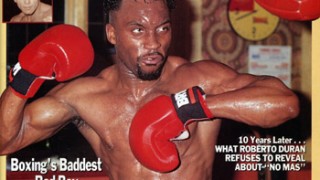 Benn: His plusses include his fantastic punching ability, his rematch performance against previous conqueror Eubank that should have earned him a win instead of a draw in their 168-pound unification contest, his nine defenses at 168 and his successful mid-career transition from all-out slugger to boxer-puncher. What hurt him with me was the way he ended his career. While still in his early 30s he produced a trio of sour losses: A decisive defeat to previous victim Thulani “Sugar Boy” Malinga and back-to-back corner retirements to Steve Collins. Perhaps the energy he burned earlier in his career had prematurely aged him but in my eyes Benn was still young enough chronologically to perform better in those fights than he did. This assessment may be overly picky on my part, but when one has limited options hard choices must be made.
Benn: His plusses include his fantastic punching ability, his rematch performance against previous conqueror Eubank that should have earned him a win instead of a draw in their 168-pound unification contest, his nine defenses at 168 and his successful mid-career transition from all-out slugger to boxer-puncher. What hurt him with me was the way he ended his career. While still in his early 30s he produced a trio of sour losses: A decisive defeat to previous victim Thulani “Sugar Boy” Malinga and back-to-back corner retirements to Steve Collins. Perhaps the energy he burned earlier in his career had prematurely aged him but in my eyes Benn was still young enough chronologically to perform better in those fights than he did. This assessment may be overly picky on my part, but when one has limited options hard choices must be made.
Camacho: Camacho’s rise to prominence was marked by electric speed, crackling charisma and a formidable mean streak. He captured belts at 130 and 135 in scintillating fashion against Rafael “Bazooka” Limon and Jose Luis Ramirez respectively and had he possessed discipline that was equal to his other gifts he may well have become boxing’s first cross-over superstar in the post-Leonard era, and a shoo-in Hall of Famer. His lack of self-control outside the ring – as well as a massive Edwin Rosario hook in round five of their June 1986 showdown – changed him forever, and not for the better. The onetime predator used his speed to neutralize threats instead of using it to threaten, and after Rosario blasted out Livingstone Bramble to win the WBA belt Camacho refused to pull the trigger on a unification rematch, a definite minus for his cause. He still had enough in the tank to win a third divisional belt at 140, win 76 of his 88 fights and record past-their-prime wins over Roberto Duran and Sugar Ray Leonard. Make no mistake, Camacho was good, even very good. But he should have been great and in my eyes he didn’t do enough to merit the precious check.
Laciar: Had I been authorized more checks I probably would have invested one on Laciar, one of the more dominant champions of the 1980s as his two WBA flyweight reigns encompassed four years and nine defenses that included five knockouts. Had it not been for a scandalously bad decision loss to Luis Ibarra, in Buenos Aires no less, Laciar’s dominance would have been even more pronounced. As it was he turned back 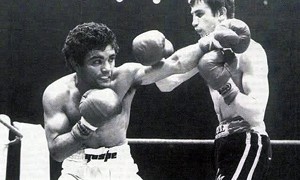 challenges from fighters boasting a combined 266-27-7 record (.858) and his best wins came against Juan Herrera, Hi Sup Shin, Prudencio Cardona and especially Zapata, who was still an excellent fighter at the time Laciar scored a decision victory. So why did he fall short here? Although he went 1-1-1 against Gilberto Roman he never truly got the best of the Mexican as his lone win came on cuts in their second match (Laciar was leading by one point on all three cards at the time of the stoppage) and many felt that the draw in their first meeting in Argentina should have gone to Roman. In the rubber match, held in California, Roman decisively out-pointed the South American. He also twice lost 10-round decisions to Raul Eduardo Perez, who was 23-20-10 and 25-23-12 at the time he met Laciar. Could those defeats be a Willie Meehan/Jack Dempsey dynamic in which a certain style unlocks normally inaccessible keys or was it the result of Laciar’s shortcomings at the time? Without any video I can’t be sure. Still, they were worth noting.
challenges from fighters boasting a combined 266-27-7 record (.858) and his best wins came against Juan Herrera, Hi Sup Shin, Prudencio Cardona and especially Zapata, who was still an excellent fighter at the time Laciar scored a decision victory. So why did he fall short here? Although he went 1-1-1 against Gilberto Roman he never truly got the best of the Mexican as his lone win came on cuts in their second match (Laciar was leading by one point on all three cards at the time of the stoppage) and many felt that the draw in their first meeting in Argentina should have gone to Roman. In the rubber match, held in California, Roman decisively out-pointed the South American. He also twice lost 10-round decisions to Raul Eduardo Perez, who was 23-20-10 and 25-23-12 at the time he met Laciar. Could those defeats be a Willie Meehan/Jack Dempsey dynamic in which a certain style unlocks normally inaccessible keys or was it the result of Laciar’s shortcomings at the time? Without any video I can’t be sure. Still, they were worth noting.
Prediction: So who will make up the Modern Class of 2015? Unlike previous years there is no “shoo-in” for enshrinement and thus deserving but long-time ballot entries have a better shot of getting in. While I would love to see Michalczewski, Zapata, Roman and about 10 other names get the recognition they deserve, I fear that, given recent voting patterns, more “fame” fighters that catch the eye of voters and will generate plenty of headlines for the ceremony in June will be granted immortality.
That cynicism about my fellow Modern voters enabled me to correctly predict all three members of the Modern Class of 2015 but I’m not so sure I’ll achieve the same batting average this year – and frankly, I hope I won’t. The guess: Hector Camacho, Michael Moorer (the best choice of the group) and Donald Curry. I also believe Vinny Pazienza and Fernando Vargas, given their high name recognition and Gatti-esque blood-and-guts approaches, could garner enough votes to get in, but given that some strong candidates will become eligible next time around – most notably Johnny Tapia and Marco Antonio Barrera – the door for Moorer, Camacho, Curry, Vargas and Pazienza will tighten.
*
After sweating over the Modern candidates I turned my attention to the other ballots. For the Non-Participants (for which I could choose as many as five) I voted for judge-turned-broadcaster Harold Lederman, longtime Nevada commissioner Marc Ratner, trainer Dai Dollings and, for the second year running, promoters Klaus-Peter Kohl and Bill Mordey. My predictions for this class: Lederman, Ratner and Kohl.
Next up was the Observers. I voted for broadcasters Antonio Andere, Steve Albert and Col. Bob Sheridan as well as historian Mario Rivera Martino and writer Jerry Izenberg. My prediction for this class: Sheridan and Izenberg with Albert being a strong possibility to unseat one of the other two.
The Old Timers were last and, as expected, they took up a considerable amount of research time. After I went through their records and whittled the names to the last 10 I called up punch-counting colleague Aris Pina, whose knowledge of the guys from way back far supersedes mine, to go over my semi-finalists. After hanging up with him I felt more solid about my choices – Tod Morgan, Leach Cross, Frank Erne, Harlem Tommy Murphy and Thomas “Pedlar” Palmer. My prediction: Morgan.
Once I signed all the ballots I stuffed them inside the self-addressed stamped envelope provided by the Hall (thanks guys) and sealed it, ending yet another set of ballot deliberations. God willing, I’ll get to do it all again next year.
*
Lee Groves is a boxing writer and historian based in Friendly, W.Va. He is a full member of the BWAA, from which he has won 13 writing awards, including 10 in the last five years and two first-place awards since 2011. He has been an elector for the International Boxing Hall of Fame since 2001 and is also a writer, researcher and punch-counter for CompuBox, Inc. He is the author of “Tales from the Vault: A Celebration of 100 Boxing Closet Classics. To order, please visit Amazon.com or email the author at [email protected] to arrange for autographed copies.















